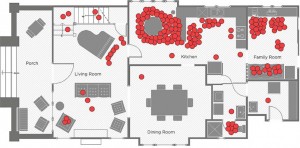 The notion of “data-driven” design gets a lot of press these days, as if what contemporary architects need is more quantitative knowledge about how people use buildings and spaces. This idea rests on misunderstandings of architecture so profound as to beggar belief. But since the idea is so common these days, it appears worthwhile to spell out exactly why it is not only wrong but harmful.
The notion of “data-driven” design gets a lot of press these days, as if what contemporary architects need is more quantitative knowledge about how people use buildings and spaces. This idea rests on misunderstandings of architecture so profound as to beggar belief. But since the idea is so common these days, it appears worthwhile to spell out exactly why it is not only wrong but harmful.
Our culture is obsessed with quantification. Data ultimately consists of numbers. As a culture, we love numbers. They are so clear, such a relief from the unremitting confusion of everyday life. Yet we all know that numbers can lie. More precisely, it is not the numbers themselves that lie, but the way they are produced and used. In spite of this, we can’t resist the urge to believe numbers. If I take something ambiguous or complex, such as people’s reactions to a movie, and ask them to rate it on a scale of five stars, suddenly the value of a (potential) work of art is reduced to a number on a five point scale. We know this is a totally bogus procedure, yet everyone pays attention to these ratings. There is a companion phenomenon that makes the process even sillier- the dilution of the ratings. Rarely do you see a movie that gets one star or five. Most get three or four. This is partly the result of our collective distaste for extreme judgments, but also, I think, from an unspoken recognition that this spurious scale is not a sufficient basis for making real judgments.
The practice of quantifying the unquantifiable is sometimes justified by the argument that the system used to quantify X may be flawed, but it’s the best we can do. This is saying that the goal of quantifying X is so important that we’re better off doing it badly than not doing it at all. The possibility that X fundamentally eludes quantification and that trying to quantify it distorts it beyond recognition is not considered.
This fallacy is especially deadly in any discussion of a cultural form such as architecture. Quantifiable measures do not even come close to describing the qualities and values of how people perceive and use space. Architecture is fundamentally ambiguous. I hope I’m not ruining anybody’s day by saying this. I’m almost embarrassed to find myself having to say it so plainly, but consider this article by David Friedlander.
Friedlander summarizes studies of how people use their homes that show that there are some spaces- formal dining rooms, outdoor patios- that are rarely used. Scandal! Inefficiency! Why do our homes include spaces we don’t use often? Well, Mr. Friedlander, let me explain. Spaces have symbolic as well as practical functions. I may not use my dining room very often, but the fact that I have one makes it possible to contemplate and engage in a particular form of socialization. This reflects my belief (which is part of my culture) in the importance of sharing meals in a formal setting for creating and maintaining important relationships with people. Devoting a space to it in my home expresses this belief.
Of course, endowing formal dining with this importance is a value not universally shared, even within my own culture. That is why many houses built in in the U.S. in the last few decades do not have dining rooms. This is as it should be. It is wrong, however, to conclude from such a study that a dining room is a waste of space.
In fairness, Mr. Friedlander goes on to make many excellent points about unsustainable patterns in the amount of land and other resources our culture consumes due to our notions of housing. He puts the cart before the horse, however, in starting from the supposed waste in our living arrangements. The unsustainable nature of how we live is the proper starting point. There we will find the true reasons for changing how we build our homes.